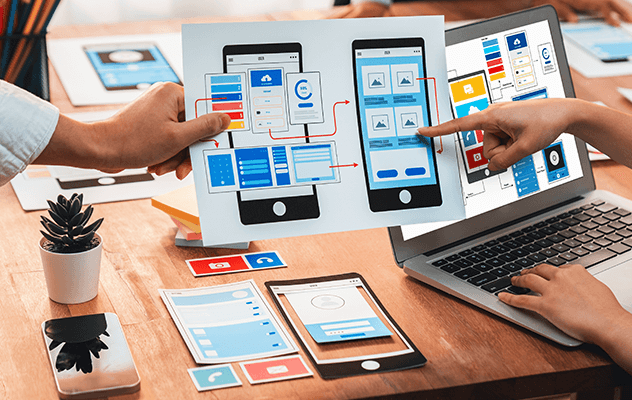
Jump To Section
As product designers and teams, we often face the challenge of finding new and imaginative design solutions or rethinking existing ones.
Inspiration can come from anywhere; from brainstorming with colleagues to conducting user research, there are a variety of techniques you can use to generate and develop ideas.
However, while the ideation process in design thinking is critical for solving problems creatively, it can often be more time-consuming, daunting, and frustrating than expected.
For this reason, having a reliable AI-supported toolkit to draw upon can vastly speed up and improve creative problem-solving outcomes.
In this blog post, we’ll explore three key tools that offer great capabilities and support for the process of ideation – allowing product designers and teams to connect ideas, identify patterns, develop prototypes as well as gain insights using data analysis – so you can unlock new pathways for innovative product design.
How AI Tools Are Transforming the Way We Approach Research and Ideation in the Design Process
Artificial intelligence (AI) has taken the world by storm, and the design industry is no exception.
In recent years, we’ve seen the introduction of AI tools that are transforming the way we approach design research and ideation.
By taking advantage of machine learning algorithms, natural language processing, and other AI techniques, designers and product teams are able to leverage massive amounts of data to generate insights, uncover trends, and make informed decisions.
Let’s take a closer look at how AI tools are changing the way we do research and ideation in the design process:
1. Enhancing User Research
User research is a crucial aspect of designing products that effectively meet the needs of the target audience.
Traditionally, this involved conducting focus groups, interviews, and surveys.
However, AI tools are making this process more efficient and accurate. Machine learning algorithms can analyze large sets of data to identify patterns and trends in user behaviour.
Tools like Google Analytics and Hotjar use AI to help designers understand how users navigate websites and products. This insight can help teams improve usability, identify pain points, and optimize user experience.
2. Streamlining Idea Generation
One of the biggest challenges in the design process is coming up with innovative ideas that meet user needs and solve business problems.
AI tools can help teams generate and evaluate ideas more efficiently. Idea management software like IdeaScale and Spigit use AI to automate the idea generation process.
These tools can quickly analyze large amounts of data to identify trends and suggest new ideas based on user feedback.
3. Automating Prototyping
Prototyping is a critical phase in the design process, as it allows teams to test and validate ideas before committing to development. But creating prototypes can be time-consuming and labor-intensive.
AI tools can automate aspects of the prototyping process.
For example, Sketch2Code is a Microsoft tool that uses AI to convert hand-drawn sketches into working prototypes. This eliminates the need for manual coding, saving time and money.
4. Augmenting Designer Creativity
While AI tools can automate many aspects of the design process, they’ll never replace human creativity. However, AI can help designers augment their creative abilities.
Augmented creativity systems use AI to analyze patterns in user behaviour and provide designers with suggestions and recommendations for new design directions. This allows designers to create more targeted and effective designs that are more likely to resonate with users.
5. Improving Decision-Making
Finally, AI tools are helping teams make more informed decisions throughout the design process. AI-powered decision support systems use algorithms to analyze data and present designers with recommendations based on that analysis.
For example, Attention Insight is a tool that uses AI to help teams identify which design changes will have the greatest impact on user engagement and conversion rates.
By leveraging these insights, teams can make better-informed decisions about design changes and improvements. This demo shows exactly how you can leverage Attention Insight to make more efficient and accurate design choices: Optimizing the Design Experience with User Research using Attention Insight
By automating aspects of the process and providing designers with insights and recommendations, AI is making it easier to create effective, innovative products that meet user needs and solve business problems.
While there’s still an important role for human creativity and intuition in the design process, AI is helping designers work more efficiently and effectively than ever before.
For design teams and product designers, AI-powered tools are quickly becoming an essential part of the toolkit, and below are three top-rated tools that help teams collaborate and execute with success.
3 Tools That Need To Be Part of Your Design Ideation Toolkit
1) Notion
Notion is a popular collaboration tool used by many design teams.
It’s an all-in-one workspace that allows for notes, to-do lists, databases, calendars, and more.
For brainstorming and ideation, Notion’s flexible workspace provides a great platform for organizing user research, sketching ideas, and collaborating with colleagues.
It comes with some great capabilities in the way of brainstorming that facilitate idea sharing. Some of the things you can do with Notion include:
- Experience seamless collaboration on a shared document, regardless of your location.
- Easily provide inline comments and tag teammates.
- Engage in asynchronous brainstorming sessions.
- Share ideas within the same space as your project management tools or team homepage.
Notion also integrates with various tools like Figma, Slack, and Gmail, providing an effortless workflow for design teams.
2) ChatGPT
ChatGPT is a powerful AI language model that can generate text-based on the prompts provided. This tool is useful for ideation because it can generate ideas based on user questions, brainstorming prompts, or even real-time feedback.
It’s particularly useful for remote teams that don’t have the luxury to brainstorm together in person.
ChatGPT’s intelligent algorithm is trained on vast amounts of data, making it incredibly effective at generating creative solutions.
In the way of brainstorming and ideation particularly for the design process, ChatGPT stands out amongst most AI tools due to its versatility.
Amongst its many benefits are:
- It saves a lot of time by evaluating research information and deriving key insights from it.
- It does competitive analysis within the context of users’ likes and dislikes.
- It helps with things like content strategy, storyboarding, design documentation and general guidance when working on something.
- It helps you set a design direction and ideate when you begin working on something new.
To understand these benefits through a use case, let’s look at this example where I used ChatGPT to improve the user experience of a fitness app.
Using ChatGPT to Improve the User Experience
My first step was to put in some data from user research to generate key insights:

The prompt I used is one answer which a user gave when asked about their experience of using a fitness app.
This is helpful when you have complex and extensive information to work with. ChatGPT generated key insights, which include the pain points as well as what the user liked.
Next, I wanted to know which fitness applications out there don’t have the issues mentioned above, so I gave it the following prompt:

The answer I got was a list of several different real-time apps that I could look into and use as an example to make design improvements on the app I was working on, making it an extremely handy software to use when it comes to analyzing what’s out there, do a quick competitive analysis, and extract funnelled information we can use ourselves.
Another great thing about ChatGPT is that you can also put in product details and design goals to brainstorm and expand on the ideation process if you’re working on a new feature, potentially uncovering some novel approaches and solutions.
For example, I wanted to create a gamified experience for an online fitness coaching feature.
For this, I gave it the following prompt:

Remarkably, ChatGPT gave me a long list of suggestions that can be incorporated in the feature when designing it:
- Achievement Badges: Award users badges for reaching specific milestones in their fitness journey. For example, a “30-day Streak” badge for consistent workouts, a “Newbie” badge for beginners, or a “Master of Yoga” badge for yoga enthusiasts.
- Points and XP System: Implement a point system where users earn points or experience points (XP) for completing workouts, attending live classes. or hitting fitness goals. These points can be used to unlock rewards or compete on leaderboards.
- Leaderboards: Create leaderboards that display users’ rankings based on their XP or points. Users can compete with friends, fellow class attendees, or the community to encourage friendly competition and motivation.
- Virtual Challenges: Introduce virtual challenges or quests that users can participate in. For example, a “Mountain Climbing Challenge” where users virtually climb mountains as they complete workouts, earning rewards upon completion.
- Avatar Customization: Allow users to create and customize their fitness avatars. As users earn XP, they can unlock new outfits, equipment, or accessories to personalize their avatars.
- Daily or Weekly Challenges: Offer daily or weekly challenges that push users to try different workouts, such as “Core Strength Monday” or “HIIT Challenge Friday.” Completing these challenges could yield extra points.
- Social Integration: Enable users to connect with friends or other app users. They can challenge each other, share achievements, and provide support, creating a sense of community.
- In-App Currency: Introduce an in-app currency that users can earn through workouts and use to purchase virtual goods, such as workout equipment, nutrition plans, or premium features.
- Progress Tracking: Provide detailed statistics on users’ progress, including calories burned, time spent working out, and improvements in strength or flexibility. Visualizing progress can be motivating.
- Leveling Up: As users earn XP. allow them to level up within the app. Each level could come with increased benefits or virtual rewards.
- Mystery Rewards: Occasionally surprise users with mystery rewards or power-ups they can use during workouts. This adds an element of excitement.
- Narrative Storytelling: Create a fitness adventure by embedding a narrative into the app. Users can progress through a story as they complete workouts, making it feel like a game.
- Multiplayer Workouts: Offer multiplayer workout sessions where users can compete or collaborate with others in real-time. This can make workouts more interactive and engaging.
- Feedback and Coaching: Provide personalized feedback and coaching based on users’ performance, helping them improve and stay motivated.
- Virtual Events: Host virtual fitness events, such as themed challenges, live classes with fitness experts, or charity runs, where users can participate and earn rewards.
With ChatGPT, I can also make different wireframes, prototype and test all of these different solutions and feature recommendations that it provided me with.
To watch my full demo explaining in detail how I use ChatGPT for my design projects, be sure to tune into this video:
3) QoQo
QoQo is Figma plugin that enables design teams to maximize their productivity and quality of output by quickly benefiting from research data.
It helps them save precious time and effort in the user research and discovery stage.
QoQo is designed specifically for UX design and is meant to serve as a companion that helps you get a broad and organized picture at the early stages of the design process.
Based on your input, it generates cards to build a persona with user goals, needs, motivations, frustrations and tasks, or it can help you identify challenges, risks and key elements for your design brief.
Final Takeaway
In conclusion, the ideation process is critical for identifying creative solutions to complex problems. There are various tools and techniques that can help facilitate the process.
Notion, ChatGPT, QoQo are some of the most popular and effective tools for the ideation stage.
Whether you choose to use one or several of these tools, it’s essential to remember that ideation is a creative process.
So don’t hesitate to try new things, experiment, and explore different perspectives with your team to develop the most innovative solutions.



